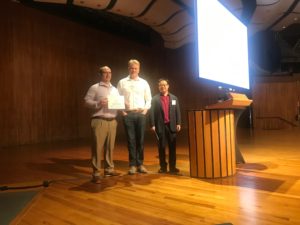
Graduate research assistant Martin Jensen was awarded the best poster award from the ACS Biomaterial Science and Engineering award at the International Nanomedicine and Drug Delivery Symposium. The international conference is a key annual event for researchers developing next-generation delivery vehicles—targeted, responsive, biodegradable nanomaterials to make diagnostics more sensitive and drugs more effective. Poster and presentation awards were selected by representatives of the ACS Biomaterial Science and Engineering journal.
Congratulations, Martin!
Biosketch:
Martin Jensen is locally grown talent. He did his undergraduate work in the Department of Chemistry at the University where he graduated with honors and received the Walter D. and Grace G. Bonner Memorial Award in Chemistry for his academic and research excellence. His undergraduate research with Dr. Robert Hitchcock worked to identify and validate new potential sources of medical device-associated infection. While an undergrad, he worked as an intern and later as an engineer at Catheter Connections, Inc. and was instrumental in helping to bring several disinfecting cap-based technologies to market. He also led the effort to refine the disinfecting techniques that reduced the disinfection time to 30 sec., six times faster than the next fastest comparable technology on the market at the time. A milestone of his career was seeing the devices he helped develop used to protect members of his family from infection while they were receiving treatment at local hospitals.
He then chose to leave industry and pursue a Ph.D. here in the Department of Biomedical Engineering under the mentorship of Dr. Hamid Ghandehari. He received a National Science Foundation (NSF) Graduate Research Fellowship, two NSF INTERN awards, and was the PI of an Allied Scientist Grant from the Society of Interventional Radiology while a graduate student. He was a prolific innovator and is an inventor on seven patent applications and invention disclosures at the University of Utah, spanning areas from improved herbicides to glues that selectively repair damaged blood vessels in the brain. While a graduate student, he has thus far been author/co-author of 17 articles, including several short editorial/opinion pieces in Science and Nature Human Behavior. He recently defended his dissertation and is transitioning to a post-doctoral research position at Harvard Medical School. His career goal is to one day lead an academic research lab that develops and translates innovative therapeutic biomaterials to address unmet medical needs.